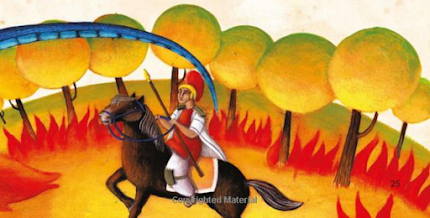Yesterday, the 23rd of April was St. George's day. St George is the patron Saint of England, usurping the former patron saint - St Edmund the martyr, when King Edward III set up the Order of the Garter in his honour in 1350. He is also the patron saint of Ethipoia, Catalonia, Georgia, Aragon in Spain and Moscow. A truly international saint in all respects, so here are some interesting facts I discovered about Saint George while doing research for my picture book George and the Dragon.
My interest in the saint preceded my research. As a child, I was fascinated by the lives of the many saints in the Catholic canon. A daily churchgoer, I have to admit I spent most of mass, not concentrating on what the priest was doing and saying, but inspecting the many, often lurid, pictures of the saints that adorned the walls. Most of these saints were early Christian martyrs, so the backdrops to their deaths were often lush Roman palaces or Middle Eastern deserts. I soon learnt to read the symbols in the paintings that often told the life stories of these brave souls who gave their lives up for their faith.
Today I realise that much of these stories was just hagiography but back then I never doubted they had actually happened. I wholly believed that the Roman guards could not budge Saint Lucy of Syracuse from her knees when they came to arrest her, not even when they hitched a whole team of oxen to her. (not sure how they managed that last bit. The pictures never showed it clearly. You just saw St. Lucy surrounded by oxen. My storyteller's imagination had to fill in the finer detail. You realise now why it was so difficult for me to concentrate on the Mass)
Every village in Malta is dedicated to a patron saint whose feast day is celebrated with great pomp and theatricality. When my cousin starting dating a handsome young shipyard worker from the village of Qormi, I was introduced to the magnificence of its patron saint: Saint George. The shipyard worker, whom my cousin married, was called George after him.)
There are many early Christian and later Muslim texts about Saint George, who was believed to be a Roman soldier of Greek descent from Cappadocia in Turkey. According to fragments of Greek texts now preserved at the British Library, George's father died for his faith when George was fourteen years old. George and his mother returned the land of her birth, Syria Palaestina. When his mother passed away, George travelled to Nicomedia, the eastern capital of the Roman Empire. He joined the Roman army and soon became known for his courage and valour. He was also a devout Christian and this drew the ire of his superior Dadianus or, in some versions of the legend, the emperor Diocletian himself. Refusing to worship Roman gods, he perished in the great Diocletian persecution of AD303. He was beheaded outside the walls of Nicomedia on 23rd April 303. His bravery in the face of death so impressed Empress Alexandra of Rome that she became a Christian too. His body was buried in his home city of Lydda (today Lod, in Israel) where his tomb is still venerated.
Today, this story is eclipsed by the legend of the dragon, first recorded in Georgia in the 11th century. It spread through Europe, mostly in the 12th century as part of The Golden Legend, a collection of hagiographies by Jacobus de Voragine. In this version, the story takes place in the city of Silene in Libya. Here the dragon terrorises a city where the people feed him two sheep a day to stop him from devouring their children. When the populace runs of out sheep, the king's daughter offers to be the sacrifice. But George arrives in time to save her and to vanquish the dragon. In gratitude, the king offers George a fabulous treasure, which the soldier distributes among the poor.
So, one saint, many legends. I love how in a world of conflict, stories still have the power to unite us.
Saviour Pirotta's version of George and the Dragon retells the Libyan version. It is published by harpercollins in their Collins Big Cats series. His latest book, The Heart Scarab is set in Ancient Egypt. It is out now. Follow Saviour on twitter @spirotta and on instagram @saviour2858






4 comments:
Thanks for this very relevant post, Saviour!
You're welcome, Penny.
Thank you for this post. You learn something new everyday.
You're welcome. Mystica.
Post a Comment